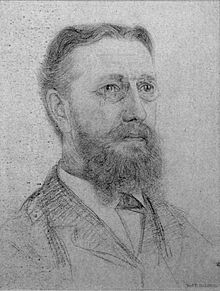Max Carl Wilhelm Weber
Max Carl Wilhelm Weber | |
|---|---|
 | |
| Born | 5 December 1852 |
| Died | 7 February 1937 (aged 84) |
| Nationality | German Dutch |
| Known for | Weber's Line |
| Spouse | Anna Weber-van Bosse |
| Awards | Foreign Member of the Royal Society[1] |
| Scientific career | |
| Institutions | University of Utrecht, University of Amsterdam, University of Bonn, Humboldt University |
| Author abbrev. (zoology) | Weber |

Max Carl Wilhelm Weber van Bosse or Max Wilhelm Carl Weber[2] (5 December 1852 – 7 February 1937) was a German-Dutch zoologist and biogeographer.
Weber studied at the University of Bonn, then at the Humboldt University in Berlin with the zoologist Eduard Carl von Martens (1831–1904). He obtained his doctorate in 1877. Weber taught at the University of Utrecht then participated in an expedition to the Barents Sea. He became Professor of Zoology, Anatomy and Physiology at the University of Amsterdam in 1883. In the same year he received naturalised Dutch citizenship.
His discoveries as leader of the Siboga Expedition led him to conclude that Wallace's Line was placed too far to the west. His studies, along with others, led to a series of alternative lines to be proposed to delimit two major biogeographic realms, the Australasian realm and the Indomalayan realm. These lines were based on the fauna and flora in general, including the mammalian fauna. Later, Pelseneer published an influential paper on this topic,[3] in which he proposed to call his preferred limit Weber's Line, to honour Weber's contributions in that field. As is the case with plant species, faunal surveys revealed that for mollusks[3] and most vertebrate groups Wallace’s line was not the most significant biogeographic boundary. The Tanimbar Island group, and not the boundary between Bali and Lombok, appears to be the major interface between the Oriental and Australasian regions for mammals and other terrestrial vertebrate groups.[4]
With G.A.F. Molengraaff, Weber gave names to the Sahul Shelf and the Sunda Shelf in 1919.[5]
Weber became member of the Royal Netherlands Academy of Arts and Sciences in 1887.[6]
Weber is commemorated in the scientific names of three species of reptiles: Anomochilus weberi, Hydrosaurus weberi, and Pachydactylus weberi.[7] Two species of mammal are also named after him: Prosciurillus weberi and Myotis weberi.[8]
Publications
[edit]- Weber, M. [W. C.] (ed.), 1890-1907. Zoologische Ergebnisse einer Reise in Niederländisch Ost-Indien, 1 (1890-1891): [i-v], i-xi, maps I-III, 1-460, pls. I-XXV; 2 (1892): [i-v], 1-571, pls. I-XXX; 3 (1894): [i-v], 1-476, pls. I-XXII; 4 (1897-1907): [i-v], 1-453, pls. I-XVI (E. J. Brill, Leiden) OCLC 60765525.
- Weber, M. [W. C.], 1902. Introduction et description de l'expedition", I. Siboga-expeditie OCLC 647132542.
- Weber, M. [W. C.], 1904b. Enkele resultaten der Siboga-expeditie. Versl. gewone Vergad. wis- en natuurk. Afd. K. Akad. Wet. Amsterdam, 12 (2): 910-914.
- Weber, M. [W. C.] & L. F. de Beaufort, 1911-1962. The fishes of the Indo-Australian Archipelago, I (1911). Index of the ichthyological papers of P. Bleeker: i-xi, 1-410, 1 portrait; II. (1913). Malacopterygii, Myctophoidea, Ostariophysi: I Siluroidea: i-xx, 1-404, 1 portrait; III. (1916) Ostariophysi: II Cyprinoidea, Apodes, Synbranchii]: i-xv, 1-455; IV. (1922) Heteromi, Solenichthyes, Synentognathi, Percesoces, Labyrinthici, Microcyprini]: i-xiii, 1-410 OCLC 646844856
Gallery
[edit]-
Portrait of Max Wilhelm Carl
-
Max Wilhelm Carl Weber and Anna Weber-van Bosse around 1890
-
Siboga expedition group portrait in laboratory
-
Siboga expedition group portrait
Taxon described by him
[edit]Taxon named in his honor
[edit]- The pipefish Cosmocampus maxweberi (Whitley, 1933) was named after him.[9]
Abyssal plain named in his honor
[edit]Weber Deep with a depth of 7,351 meters, (24,117 feet, 4.56 miles) in the Banda Sea. [10]
See also
[edit]References
[edit]- ^ Thompson, D. W. (1938). "Max Wilhelm Carl Weber. 1852-1937". Obituary Notices of Fellows of the Royal Society. 2 (6): 346–355. doi:10.1098/rsbm.1938.0017.
- ^ Watkins, M. & Boelens, B. (2015): Sharks: An Eponym Dictionary. pp. 219. Pelagic Publishing. ISBN 978-1-907807-93-0.
- ^ a b Pelseneer, Paul (1904). "La ligne de Weber, limite zoologique de l'Asie et de l'Australie". Bulletin de la Classe des Sciences Académie Royale de Belgique. 1904: 1001–1022.
- ^ "Archived copy" (PDF). Archived from the original (PDF) on 2009-03-06. Retrieved 2009-09-26.
{{cite web}}: CS1 maint: archived copy as title (link) page 3-82 - ^ Ballard, Chris (1993). "Stimulating minds to fantasy? A critical etymology for Sahul". Sahul in review: pleistocene archaeology in Australia, New Guinea and island Melanesia. Canberra: Australian National University. p. 17. ISBN 0-7315-1540-4.
- ^ "Max Wilhelm Carl Weber (1852 - 1937)". Royal Netherlands Academy of Arts and Sciences. Retrieved 17 July 2015.
- ^ Beolens, Bo; Watkins, Michael; Grayson, Michael (2011). The Eponym Dictionary of Reptiles. Baltimore: Johns Hopkins University Press. xiii + 296 pp. ISBN 978-1-4214-0135-5. ("Weber", p. 280).
- ^ Weber, Max (1890). Zoologische Ergebnisse einer reise in Niederländisch Ost-Indien. Bd. 1-4. Leiden: E.J. Brill. doi:10.5962/bhl.title.52289. S2CID 86156252.
- ^ "Biographical Etymology of Marine Organism Names. VW". Hans G. Hansson. Retrieved 27 May 2018.
- ^ Dutch Oceanographic Research in Indonesia, BY HENDRIK M. VAN AKEN. Oceanography Vol. 18, No. 4, Dec. 2005. 30.
Citations
[edit]- Querner, H., 1976. Weber, Max Wilhelm Carl. In : C. C. Gillispie (ed.), Dictionary of scientific biography, 14 : 203 (Charles Scribner's Sons, New York).
- Pieters, Florence F. J. M. et Jaap de Visser, 1993. The scientific career of the zoologist Max Wilhelm Carl Weber (1852-1937). Bijdragen tot de Dierkunde, 62 (4): 193-214.
External links
[edit]- 1852 births
- 1937 deaths
- Biogeographers
- 20th-century Dutch zoologists
- Explorers of Indonesia
- 19th-century German zoologists
- Foreign members of the Royal Society
- Members of the Royal Netherlands Academy of Arts and Sciences
- Scientists from Bonn
- Academic staff of the University of Amsterdam
- University of Bonn alumni




